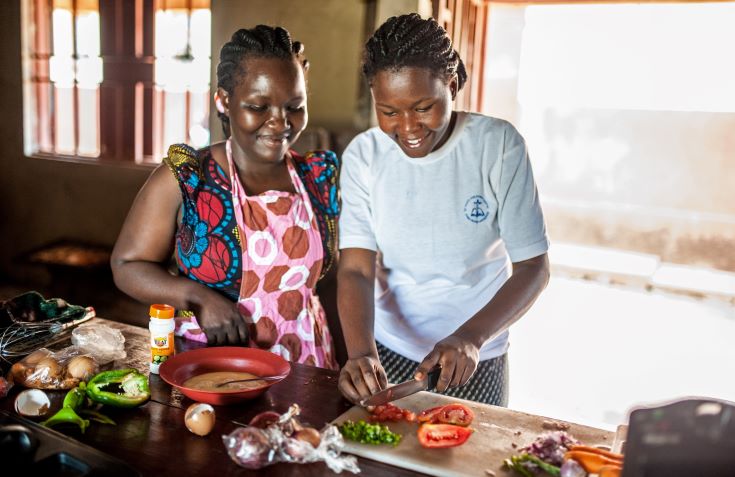The disability programme trying to bridge the disconnect between talent and acquisition
A new UK aid-funded programme directed by Sightsavers in collaboration with various cross-sector partners, has set out to overcome employment barriers that prevent millions of people with disabilities from accessing employment. To learn more, ahead of their participation at AidEx 2019 conferences in Nairobi and Brussels this year, AidEx Voices spoke to Simon Brown, Technical Lead for Economic Empowerment for the programme known as Inclusion Works.

23-year-old Grace Kabagenyi makes an omelette with the help of her teacher in her catering class at a vocational school in Masindi, Uganda. Grace is deaf and enrolled into an EU funded programme Connecting the Dots which is run by Sightsavers (Image: P Aurelie Marrier d'Unienville|Sightsavers 2017)
An estimated one billion people around the world – 15 per cent of the population – live with disabilities, making this group the world’s largest minority. Of these, 80 per cent live in developing countries.
Launched in July 2019, Inclusion Works is a three-year programme led by Sightsavers alongside ten partners, piloting new ways to create job opportunities for people with disabilities in Kenya, Uganda and Bangladesh by working with 100 private and public employers.
What has held back people with disabilities?
Widespread societal stigma has played a significant role in the marginalisation of people with disabilities. Underpinned by cultural and religious beliefs, misconceptions such as disability being a product of punishment or bad luck, have fostered prejudice, discrimination, shame and abuse.
Self-limitation derived from marginalisation has held back people with disabilities from utilising the opportunities that exist, such as job roles specifically designed to be inclusive. Growing up with assumed limited capacity nurtures a lack of confidence in skills and ability, ultimately diminishing aspirations.
Brown comments: “It is often a case of people having the right qualifications, but not applying to those companies that are trying to be inclusive.” He explains the disconnection within this supply and demand relationship, saying that it means there are people with the right skills, but companies have to go the extra mile to find them. “We want to understand why this is the case,” he continues.
A dearth of data has been another crucial factor in preventing progress in this area. There is a combination of people either not self-identifying as disabled, or their families not identifying them. The absence of statistics and tracking tools has, in turn, inhibited comprehensive reporting on programmes supporting people with disabilities. Meanwhile, the implementation of policies like employment quotas and education systems has lacked enforcement and they have had scarce representation as a result.
An informed, collaborative approach
With more data and definitions required, Inclusion Works has set out to gain a comprehensive picture of the labour market. The questions driving these assessments seek to discover how companies and employers articulate their demand for people and skills, how this connects with the labour market, how those skills are supplied, and how they link back to demand. Labour market assessments involving progressive conversations with government departments and employers so far, have caused Sightsavers and the team to question their assumptions: “We are beginning to understand there is an interest from employers to be more inclusive but there are these barriers preventing this. We are learning how best to work together to come up with solutions to smash these barriers,” says Brown.
While the programme aims to get more than 2,000 people with disabilities into employment over the next three years, the approach is principally about system change as opposed to the traditional individual-to-individual basis. Brown asserts: “It is about how we can go about changing parts of the system that can then be replicated on a wider scale later.”
The powerful ability to fail
Historically, the approach between the private and development sector has been confrontational, but collaboration is key to moving past any mistrust. Companies such as Safaricom in Kenya have been exemplary pioneers in demonstrating how a philanthropic social responsibility initiative can evolve from sympathetic, to strategically advantageous and meaningfully inclusive.
Inclusion Work’s method will be iterative, where constant action learning throughout the cycle allows for trial and error. Brown says that as a new kind of programming for the sector, there is a natural risk of failure. “But we have to accept some of the things we try will fail, so long as we can rapidly learn why in cycles of learning,” he continues.
Brown refers to a comment made by a programme manager in Kenya who said she felt that: “Disability now is at a point where gender was in the 1990s.” The Washington Group definitions demonstrate that disability is becoming more of a priority issue with an ambition to do positive work, but much more work is required if we want to attain high quality statistics so that we can ensure all country censuses have a definition and approach encouraging the identification of disabilities.
Whether the research finds that it is systems that need to be more inclusive, or people with disabilities who need to know how to better interact with the system, Inclusion Works is aware it can only be successful if every step of the way is directly informed by voices from the very people who should be benefitting from it. This is precisely why the programme works through disabled people’s organisations on the ground, through the International Disability Alliance with Sightsavers’ support.
Nothing about us, without us, indeed.
This blog was contributed by Anastasia Kyriacou on behalf of Aidex Voices. Thumbnail: macrovector|123rf
Anastasia Kyriacou, 09/08/2019